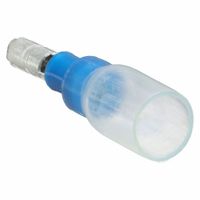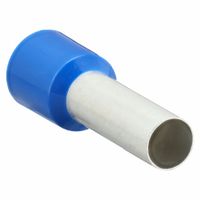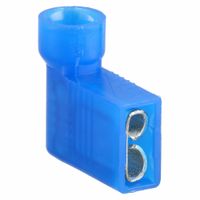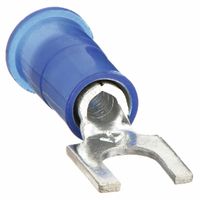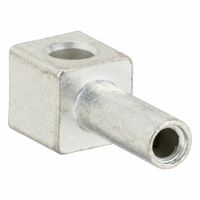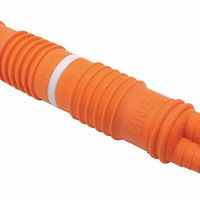Call +(254) 703 030 000 / 751 483 999 / 721 704 777
- Home
- Electrical
- Electrical Connectors Wiring Devices
- Wire Connectors Terminals Terminal Blocks
- Wire Terminals Disconnects
.....Read More
Frequently Asked Questions
What are the different types of wire terminals and disconnects?
Wire terminals and disconnects are essential components in electrical systems, providing secure connections and facilitating easy disconnection. Here are the different types:
1. **Ring Terminals**: These have a ring-shaped end that fits over a stud or bolt, providing a secure connection. They are commonly used in automotive and industrial applications.
2. **Spade Terminals**: Shaped like a fork, these terminals allow easy connection and disconnection without removing the screw completely. They are often used in household appliances and automotive wiring.
3. **Butt Connectors**: Used to connect or splice two wires together, these cylindrical connectors are crimped on both ends to secure the wires.
4. **Quick-Disconnect Terminals**: Also known as slip-on or fast-on connectors, these allow for rapid connection and disconnection. They are often used in applications requiring frequent maintenance.
5. **Bullet Connectors**: These have a bullet-shaped male end that fits into a female receptacle, providing a secure connection that can be easily disconnected.
6. **Pin Terminals**: Featuring a pin-shaped end, these terminals are used in applications where a wire needs to be inserted into a terminal block or connector.
7. **Flag Terminals**: These have a right-angle design, making them suitable for connections in tight spaces.
8. **Hook Terminals**: Similar to spade terminals but with a hook shape, they are used for quick connections to screw terminals.
9. **Insulated Terminals**: These have a plastic or rubber sleeve to prevent short circuits and provide strain relief.
10. **Non-Insulated Terminals**: Lacking insulation, these are used in applications where insulation is not a concern.
11. **Twist-On Wire Connectors**: Also known as wire nuts, these are used to connect multiple wires together by twisting them into the connector.
12. **Push-In Wire Connectors**: Allow wires to be pushed into the connector for a secure connection without the need for tools.
How do you choose the right wire terminal for your application?
To choose the right wire terminal for your application, consider the following factors:
1. **Wire Gauge**: Match the terminal to the wire gauge to ensure a secure connection. Terminals are typically labeled with the wire sizes they accommodate.
2. **Material**: Choose a terminal material compatible with the environment. Copper is common for its conductivity, while brass offers corrosion resistance. For harsh environments, consider tin-plated or nickel-plated terminals.
3. **Insulation**: Decide between insulated and non-insulated terminals. Insulated terminals prevent short circuits and are ideal for environments where wires may touch. Non-insulated terminals are suitable for applications where insulation is not a concern.
4. **Type of Terminal**: Select the terminal type based on the connection needed. Common types include ring, spade, butt, and quick-disconnect terminals. Ring terminals provide a secure connection, spade terminals allow easy removal, butt connectors join two wires, and quick-disconnects offer fast connections.
5. **Current Rating**: Ensure the terminal can handle the current load of your application. Exceeding the current rating can lead to overheating and failure.
6. **Environmental Conditions**: Consider temperature, moisture, and exposure to chemicals. Use terminals with appropriate ratings for high temperatures or moisture-resistant features for wet conditions.
7. **Vibration and Movement**: For applications with vibration, choose terminals with features like locking mechanisms to prevent disconnection.
8. **Compliance and Standards**: Ensure terminals meet industry standards and certifications relevant to your application, such as UL or CSA.
9. **Installation Method**: Consider the tools required for installation. Some terminals require crimping tools, while others may need soldering.
By evaluating these factors, you can select a wire terminal that ensures reliability, safety, and efficiency for your specific application.
What is the difference between ring terminals and fork terminals?
Ring terminals and fork terminals are both types of electrical connectors used to attach wires to a connection point, such as a screw or a stud. The primary difference between them lies in their design and application:
1. **Design**:
- **Ring Terminals**: These have a closed, circular end that resembles a ring. The wire is crimped into the opposite end, and the ring is placed over a stud or screw. The closed design ensures a secure connection, as the terminal cannot slip off unless the screw is completely removed.
- **Fork Terminals**: These have an open-ended, U-shaped design that resembles a fork. The wire is crimped into one end, and the forked end is placed under a screw or stud. The open design allows for easy installation and removal without completely removing the screw.
2. **Application**:
- **Ring Terminals**: Used in applications where a secure, permanent connection is required. They are ideal for environments with vibrations or where the connection should not come loose easily.
- **Fork Terminals**: Used in applications where quick installation or removal is necessary. They are suitable for situations where connections need to be frequently changed or adjusted.
3. **Security**:
- **Ring Terminals**: Provide a more secure connection due to their closed design, reducing the risk of accidental disconnection.
- **Fork Terminals**: Offer less security compared to ring terminals, as they can potentially slip out if the screw loosens.
4. **Installation**:
- **Ring Terminals**: Require the complete removal of the screw or nut for installation.
- **Fork Terminals**: Allow for installation without fully removing the screw, saving time and effort.
In summary, the choice between ring and fork terminals depends on the need for security versus convenience in installation and maintenance.
How do you properly crimp a wire terminal?
1. **Select the Right Terminal and Tool**: Choose a terminal that matches the wire gauge. Use a crimping tool designed for the terminal type.
2. **Strip the Wire**: Strip the insulation from the wire end using a wire stripper. Remove just enough insulation to fit into the terminal barrel, typically about 1/4 inch.
3. **Insert the Wire**: Insert the stripped wire into the terminal barrel. Ensure all wire strands are inside the barrel and the insulation is close to the barrel's edge.
4. **Position the Terminal in the Crimping Tool**: Open the crimping tool and place the terminal in the appropriate slot. The terminal's seam should face away from the crimping tool's indent.
5. **Crimp the Terminal**: Squeeze the crimping tool handles firmly until the tool releases. This ensures a secure crimp. For ratcheting crimpers, ensure the tool completes its cycle.
6. **Inspect the Crimp**: Check the crimp visually. The wire should be secure, with no strands exposed. The terminal should not be deformed.
7. **Test the Connection**: Gently tug on the wire to ensure it is securely crimped. The wire should not pull out of the terminal.
8. **Seal the Connection (if necessary)**: For environmental protection, use heat shrink tubing or a similar method to seal the connection.
9. **Repeat as Needed**: Repeat the process for additional connections, ensuring consistency in each crimp.
10. **Safety Precautions**: Always wear safety glasses and follow tool manufacturer instructions to prevent injury.
What are ferrules used for in electrical connections?
Ferrules are used in electrical connections to ensure secure, reliable, and efficient connections between wires and terminals. They are small metal tubes, often made of copper or tin-plated copper, that are crimped onto the end of stranded wires. The primary purposes of ferrules in electrical connections include:
1. **Improved Connection Quality**: Ferrules prevent the fraying of stranded wires, ensuring that all strands are held together tightly. This results in a more stable and consistent connection when inserted into terminal blocks or connectors.
2. **Enhanced Safety**: By preventing stray wire strands, ferrules reduce the risk of short circuits and electrical arcing, which can lead to equipment damage or fire hazards.
3. **Ease of Installation**: Ferrules simplify the process of inserting wires into terminal blocks. The solid, cylindrical shape of a crimped ferrule makes it easier to insert into connectors, reducing installation time and effort.
4. **Increased Durability**: Ferrules protect the wire ends from mechanical stress and vibration, which can cause wire strands to break over time. This increases the longevity and reliability of the electrical connection.
5. **Corrosion Resistance**: The materials used for ferrules, such as tin-plated copper, offer resistance to corrosion, which is crucial in maintaining the integrity of electrical connections in harsh environments.
6. **Standardization and Compliance**: Using ferrules can help meet industry standards and regulations, ensuring that electrical installations are compliant with safety and quality requirements.
Overall, ferrules are essential components in electrical systems, providing a secure and efficient means of connecting wires to terminals, enhancing both performance and safety.
How do quick disconnects work and where are they used?
Quick disconnects, also known as quick couplers or quick release fittings, are devices designed to allow fast and easy connection and disconnection of fluid lines, pneumatic systems, or electrical connections without the need for tools. They typically consist of two main components: a male plug and a female socket. When these components are pushed together, they lock into place, creating a secure and leak-proof connection. To disconnect, a simple mechanism, such as a sleeve or button, is activated to release the connection.
These devices work by employing a locking mechanism, often using ball bearings or a latch, that holds the male and female parts together. Seals, such as O-rings, are used to prevent leaks. In some designs, valves are integrated to automatically shut off the flow of fluid or gas when disconnected, preventing spills or leaks.
Quick disconnects are used in a variety of applications across different industries. In hydraulic systems, they allow for the rapid connection and disconnection of hoses and components, facilitating maintenance and equipment changes. In pneumatic systems, they are used to connect air tools and compressors. In the automotive industry, quick disconnects are found in fuel lines and cooling systems. They are also used in medical equipment for connecting tubing and in the electronics industry for connecting cables and wires.
Overall, quick disconnects enhance efficiency, safety, and convenience by simplifying the process of connecting and disconnecting components in various systems.
What are the benefits of using bullet disconnects in electrical systems?
Bullet disconnects offer several benefits in electrical systems:
1. **Ease of Use**: Bullet disconnects are designed for quick and easy connection and disconnection, facilitating maintenance and repairs without the need for specialized tools.
2. **Versatility**: They are suitable for a wide range of applications, including automotive, marine, and industrial systems, accommodating various wire sizes and types.
3. **Secure Connection**: The design ensures a reliable and secure connection, reducing the risk of accidental disconnection due to vibrations or movement.
4. **Space Efficiency**: Bullet disconnects are compact, making them ideal for use in tight spaces where larger connectors might not fit.
5. **Cost-Effective**: They are generally inexpensive, providing a cost-effective solution for creating reliable electrical connections.
6. **Durability**: Made from materials like brass or copper with protective coatings, bullet disconnects are resistant to corrosion and wear, ensuring long-term performance.
7. **Flexibility**: They allow for easy modification and expansion of electrical systems, as components can be added or removed without extensive rewiring.
8. **Safety**: By providing a secure and stable connection, bullet disconnects help prevent electrical shorts and potential hazards.
9. **Reduced Installation Time**: Their simple design and ease of use can significantly reduce installation time, improving overall efficiency in system assembly.
10. **Minimal Tool Requirement**: Often, only basic tools are needed for installation, making them accessible for both professional and DIY applications.
These benefits make bullet disconnects a popular choice for creating efficient, reliable, and safe electrical connections in various systems.

